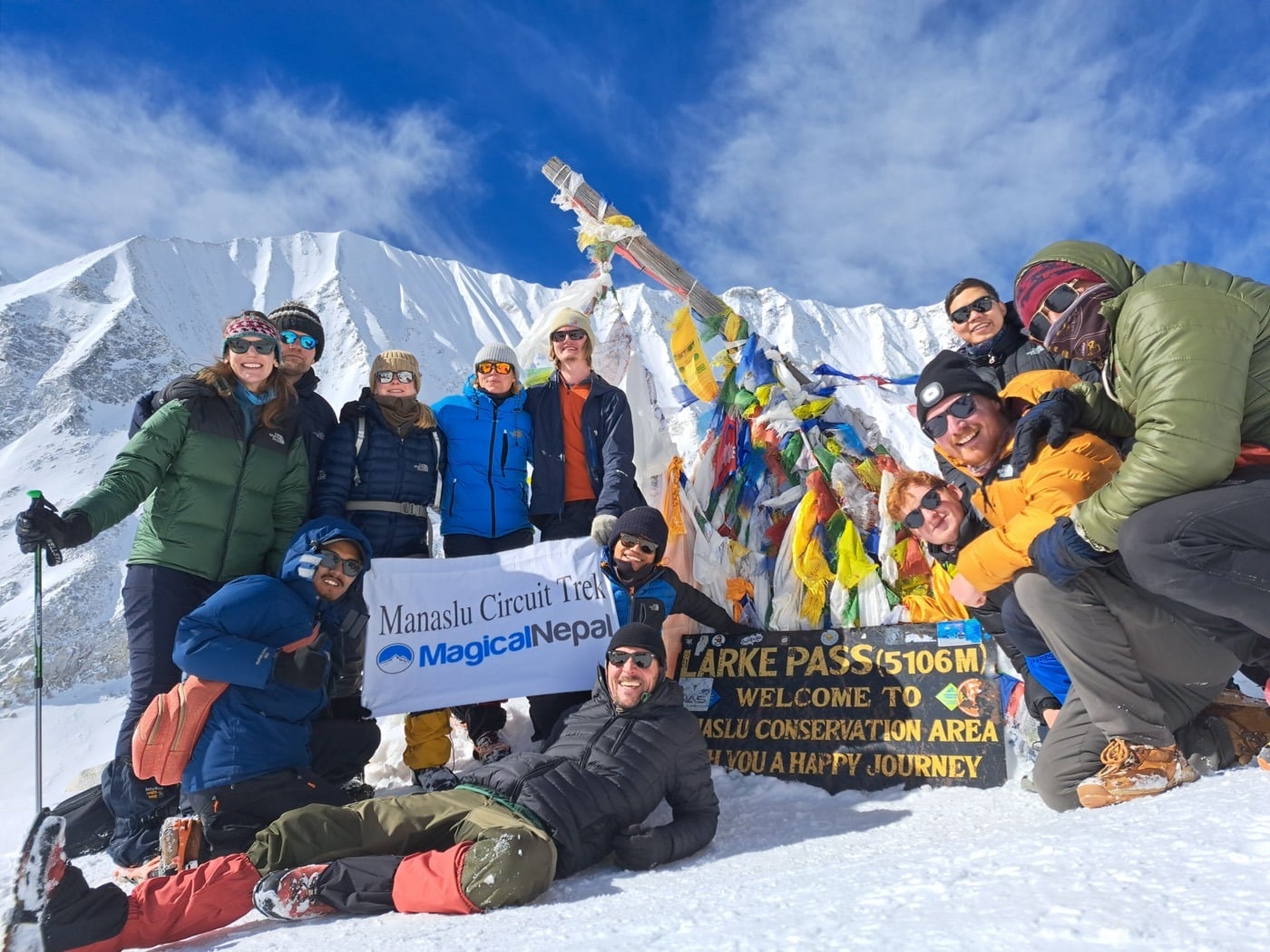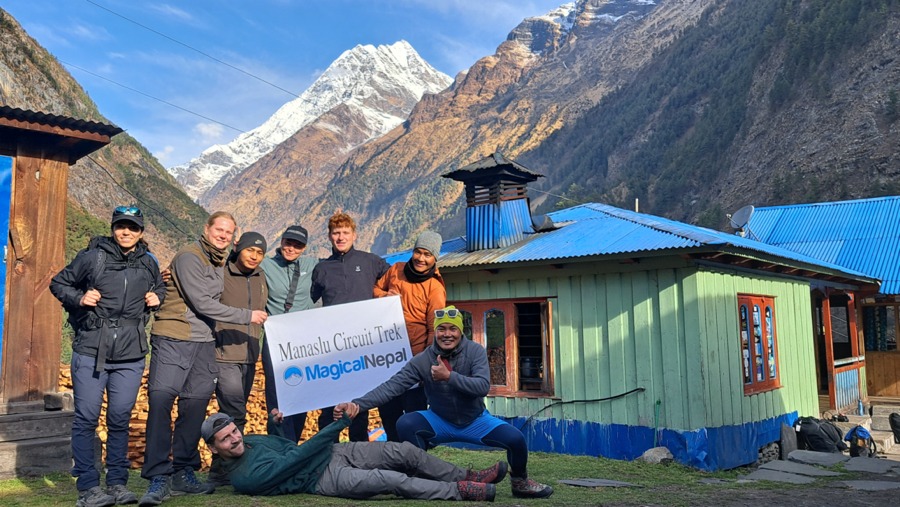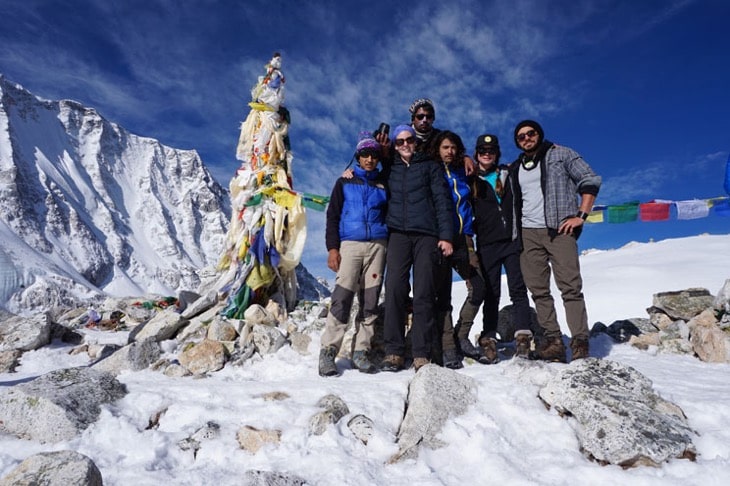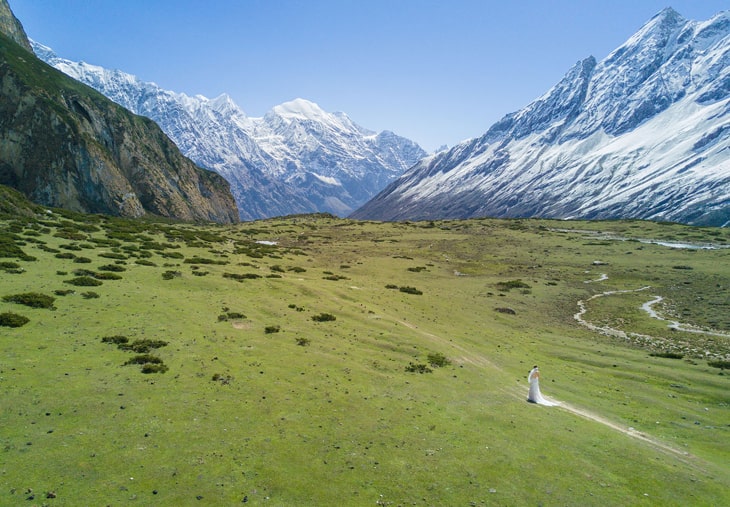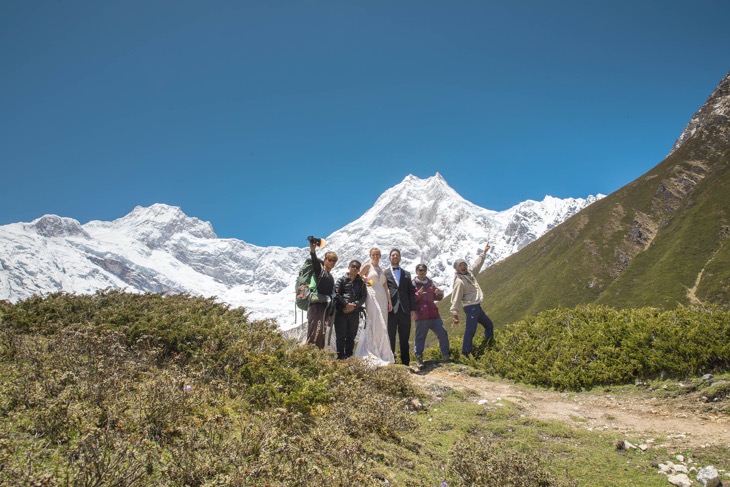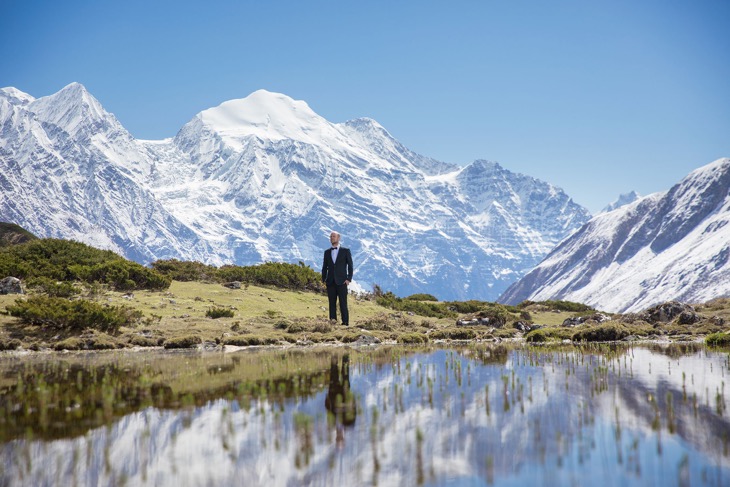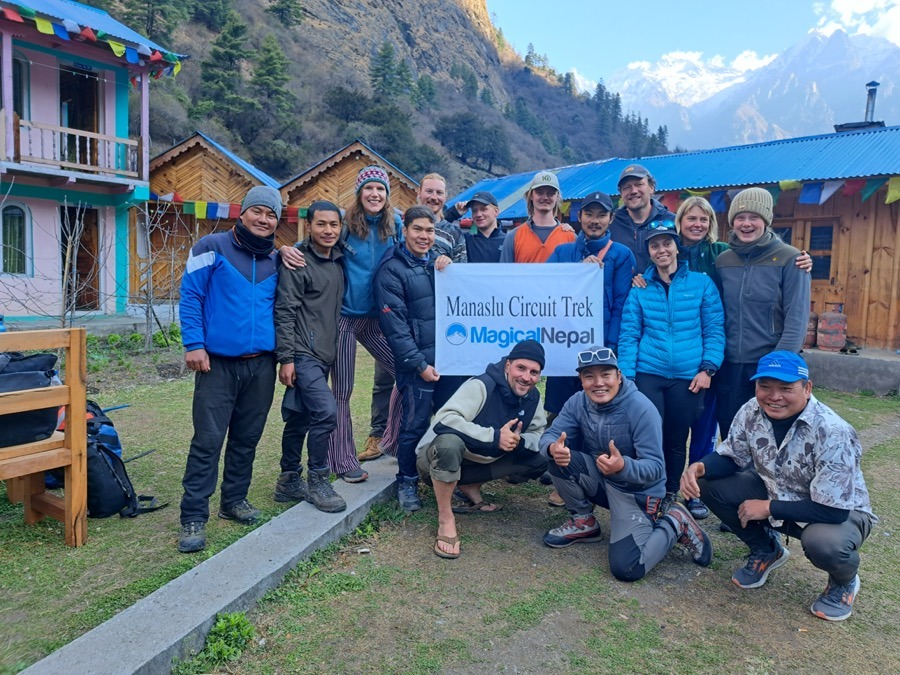Manaslu Circuit Trek
The Manaslu circuit trek is one of the best treks in Nepal. It takes you around the Manaslu Conservation Area and leads to a breathtaking view of the eighth-highest mountain in the world.
This trek can be a great alternative if you’ve already been to the Annapurna Circuit. The Manaslu Circuit Trek is a 13-day trek that starts at Soti Khola and ends at Beshi Sahar. It can be extended to 22 days with an additional side trek to the Tsum Valley.
Flanked by the Annapurna’s to the West and Ganesh Himal to the East, it is one of the most graceful of the 8000-meter giants.
Unlike the Everest Base Camp Trek, flooded with trekkers worldwide, the Manaslu circuit trek usually sees fewer people along its route. It is remote and physically demanding yet culturally enriching and scenically uplifting.
The circuit takes you from the steamy lowlands with their rice and millet terraces through the mighty gorges of the Budi Gandaki, with their turquoise waters and amazing waterfalls. The suspension bridges in the Manaslu trek are in a league of their own for both length and height, and the yearly monsoon often washes minor bridges away, leaving trekkers to use semi-submerged rocks.
Only opened to a maximum of 400 trekkers in 1992, this trek still feels like a pioneering expedition. If you want to know what trekking in the 1980s was like, the Manaslu circuit trek is a visual feast from start to finish, but you better be fit.
Slowly, you wind North to the snowbound Larkya La Pass beside the Tibetan border. The altitude here is a problem but almost forgotten with the jaw-dropping views of Manaslu. At 5,167 meters/16,952 feet, Larkya La Pass is usually snow-covered and icy. Micro crampons are often used on the descent. Trekking to the pass requires a 3 am start to make the highest point before the winds come, usually around mid-morning.
From the pass, looking back the way you have come gives a clear view, but by far, the most amazing view comes after you have left the pass and walked along a corridor to the west.
A great glacial cirque bursts into view. A stupendous wall created by Cheo Himal, Himlung Himal, Nemjung, Gyaji Kang, and Kang Guru casts down a stream of glaciers while Annapurna II rises ahead. This view alone makes the trek worthwhile. Magical Nepal can arrange your all-inclusive 13-day trek. The trek can be done on a teahouse unless you want to go off-route, where camping is the only option.
| Starts at: Maccha Khola | Ends at: Besisahar |
| Trek Region: Manaslu | Transport: Public Bus |
| Duration: 13 Days | Trip Grade: Challenging |
| Max Altitude: 5167 m / 16752 ft (Larkya Pass) | Accommodation: Basic teahouses |
Manaslu Circuit Trek Highlights
- The jaw-dropping natural beauty of the forests, rivers, and flora in the Manaslu region
- Friendly people, and rich culture of the region, which includes both Nepalese & Tibetan ethnic groups
- Larky La Pass (5,167 m / 16,952 ft), the highest point on the trek
- Stunning view of some of the highest peaks in the world- Manaslu, Himlung, Annapurna II
- Abundant wildlife, including Tahr, Agali, Pika, Himalayan Marmots, and if lucky, Snow Leopard
Manaslu Circuit Trek Outline Itinerary
Day 1: Drive from Kathmandu to Maccha Khola
Maccha Khola – 930 m / 3,051 ft -9 hrs
Day 2: Trek from Maccha Khola to Jagat
Jagat – 1,340 m /4,396 ft – 6 hrs
Day 3:Trek from Jagat to Deng
Deng – 1,804 m / 5,918 ft – 6 hrs
Day 4:Trek from Deng to Namrung
Namrung – 2,630 m / 8,628 ft – 6 hrs
Day 5:Trek from Namrung to Lho
Lho – 2,957 m / 9,701 ft – 4 hrs
Day 6: Lho to Sama Gaun
Sama Gaun – 3.530 m / 11,581 ft – 4 hrs
Day 7: Acclimatization Day (Day Trip to Manaslu Base Camp or Pungyen Gompa)
Sama Gaun – 4,400m / 14,435 ft – 7 hrs
Day 8: Trek from Sama Gaun to Samdo
Samdo – 3,865 m / 12,680 ft – 3 hrs
Day 9: Acclimatization Day (Day Trip to Tibet Border)
Samdo – 5,000 m / 16,404 ft – 8 hrs
Day 10: Trek from Samdo to Dharmasala
Dharmasala – 4,460 m / 14,632 ft – 4 hrs
Day 11: Trek from Dharmasala to Bimthang via Larkya Pass
Bimthang – 3,590 m / 11,778 ft – 10 hrs
Day 12:Trek from Bimthang to Dharapani
Dharapani – 1,970 m / 6.463 ft – 7 hrs
Day 13:Trek from Dharapani to Kathmandu (Drive)
Kathmandu – 1,300 m / 4,265 ft – 10 hrs
Day 1: Kathmandu to Maccha Khola (Drive)
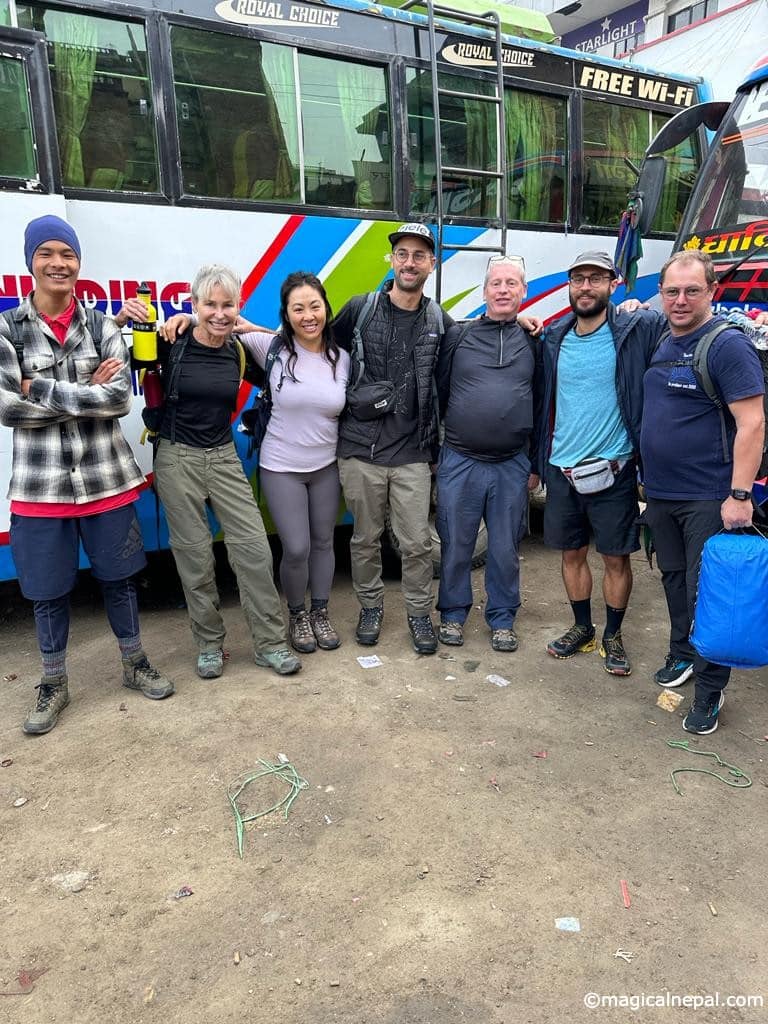
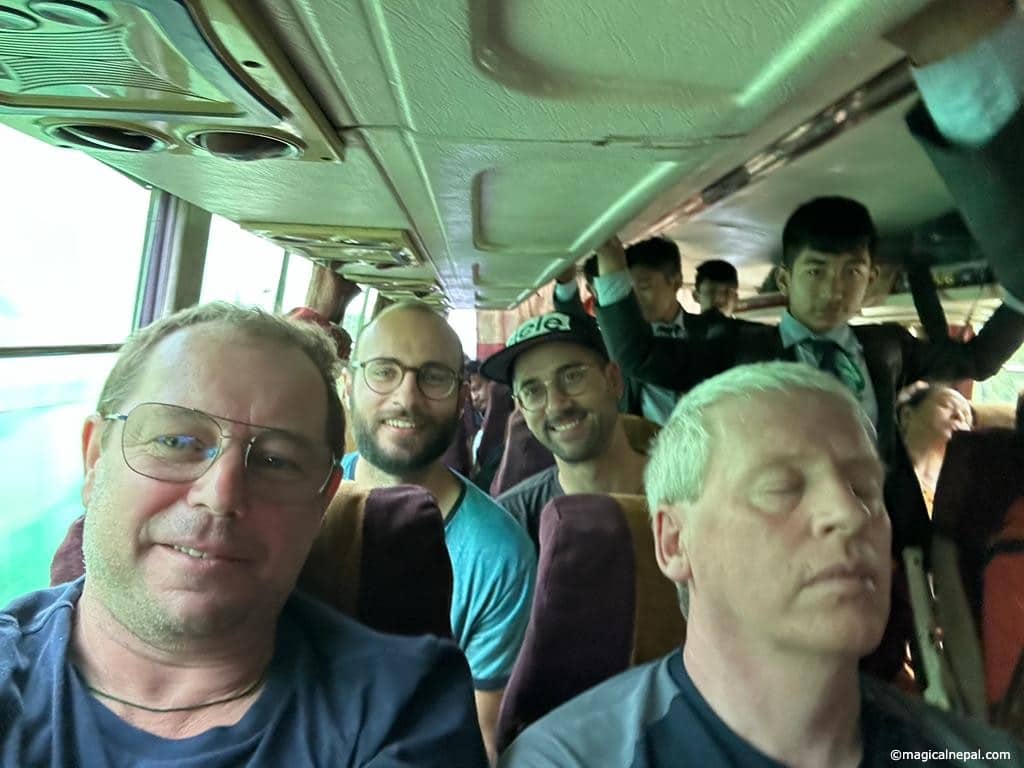
- Drive time: 8 to 9 hours
- Accommodation: Tea House
- Distance: 160 km / 99 miles
Your trek to Manaslu Circuit begins from Kathmandu. To start, you can take a direct bus at 6 a.m. and 8 a.m. from Gongabu Bus Park, Kathmandu, to Arughat. You can also take the bus to Dhading or Malekhu on the Prithvi Highway and then take the local bus or jeep thereafter.
Our guide will pick you up at your hotel and take you to the bus station by taxi. We recommend you have breakfast or ask your hotel to pack it. The bus will stop on the way for a toilet break and lunch.
Although the road is dusty and bumpy, you will catch the best landscape views from your window seat. You can stop at many rest stops for short breaks and meals. Overnight at one of the teahouses in Maccha Khola
Day 2: Maccha Khola to Jagat
- Trek time: 5 to 6 hours
- Accommodation: Tea House
- Distance: 14 km / 8.6 miles
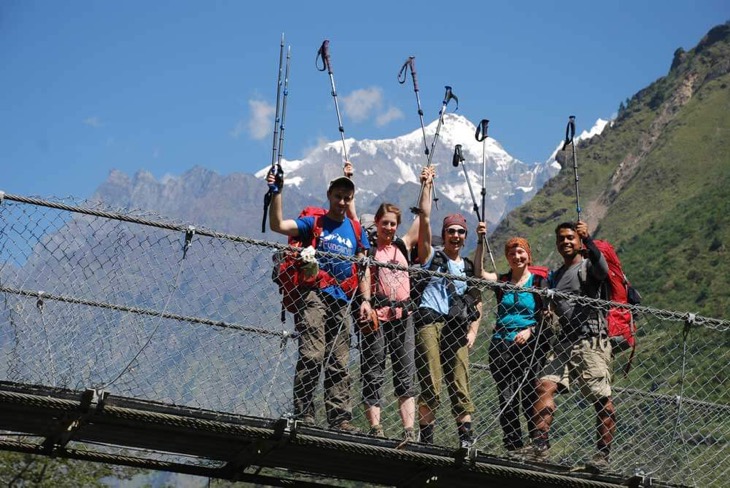
The following day, you will start walking across the twisting road on the bank of the Budi Gandaki River. You will witness many monkeys and langurs as you enter the forest trail.
After the forest, you will walk to the Gurung villages, like lower Khorlabeshi. In the village, you will notice the shepherds clad in a typical smoke-browned cape called Bokkhu.
Walking further, you will reach Tatopani ‘hot water’, where you can take warm showers and relax your soaring body. After relaxing in the hot water, you cross a new suspension bridge over the Bhudi Gandaki River to reach Doban.
After a landslip and Yaruphant, you cross a wooden bridge to the left of the Buri Gandaki river and avoid a torturous 3-hour climb up Gurung village trails.
Following the waves, the river flattens at Yaru, from where you cross a long cantilever bridge to Jagat, a neatly flagstoned Gurung village. Upon entering the village, you must verify your trekking permits at the check post. From this day on, you will be walking in the restricted region.
Day 3: Jagat to Deng
- Trek time: 5 to 6 hours
- Accommodation: Tea House
- Distance: 19.9 km / 12.3 miles
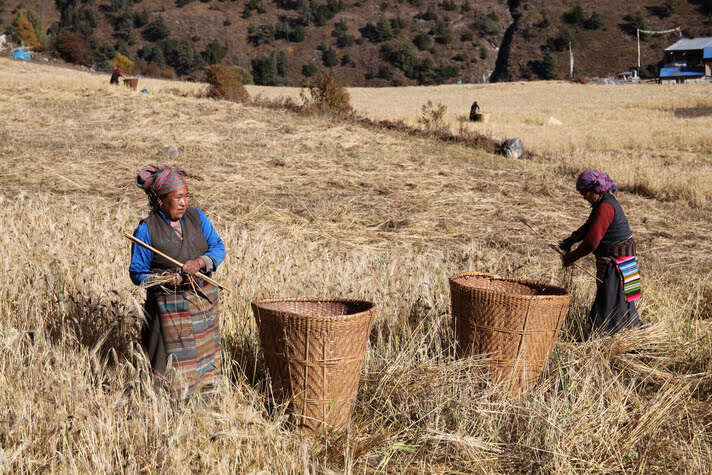
The next day, you will walk to Salleri and descend to Sirdibas. The village welcomes you with several gompas and Buddhist prayer flags. At many stopovers on the route, you can also try the local alcohol before you reach Phillim. At Phillim, you will have your permits checked, and then you will continue along the western bank of the river.
The trail is beautiful, with unique sculptures over the boulders on the river bank formed due to river water. Leaving the riverbank, you proceed through rhododendron forests, Himalayan pine, and the overhanging rocks on the towering peaks. These highlights beautify the trail.
On proceeding further, you cross the Siyar Khola bridge and reach a junction where the trail separates Tsum Valley on your right.
Finally, you will reach Pewa. Just a little further, you will reach Deng, where you can finally rest for the day.
You can gather around the fireplace in the evening and share your experiences with fellow trekkers and locals before you go to bed.
Day 4: Deng to Namrung
- Trek time: 5 to 6 hours
- Accommodation: Tea House
- Distance: 20 km / 12 miles
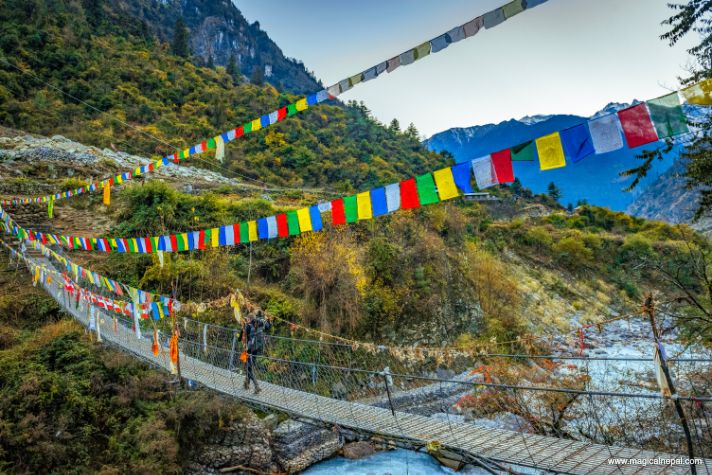
After the sun rises, you will have breakfast and start the day’s trek. Before ascending the winding trails, you will walk across the bamboo forest to reach Deng.
Moving further, you will cross a suspension bridge to climb to Rana and Bihi Phedi. On the trail, White-Faced monkeys visit villages looking for free food.
The trail then proceeds to Ghap through several landslide zones. At this point, you must be extra careful as you walk. Plus, you must be attentive to your guide’s instructions to maintain physical safety. After the landslide zone, you will follow the trail up to Namrung.
After about 1hr on the uneven trail, you will climb a zigzag from the river to the neat village of Namrung (2660m).
The place has some of the best teashops, a restaurant, and rest houses on the trek. A local businessman worked for over a decade in Hong Kong, then returned to Namrung and built a modern restaurant and hotel with Cappuccinos and WiFi.
Day 5: Namrung to Lho
- Trek time: 3 to 4 hours
- Accommodation: Tea House
- Distance: 10 km / 6 miles
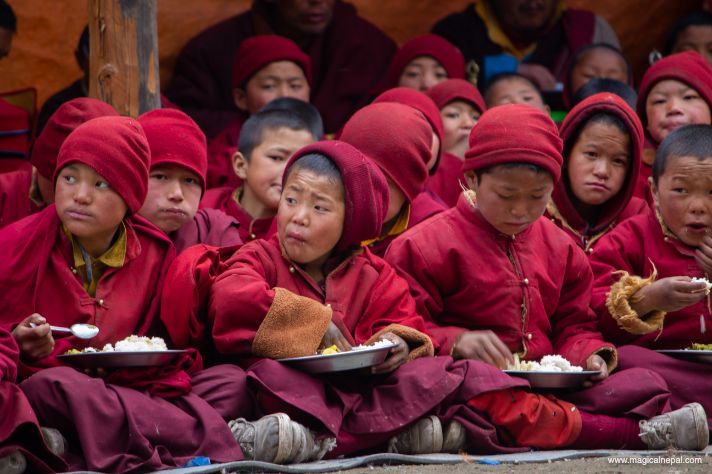
Witnessing the lifestyles of the Nubri people, you will start the day. Exploring their Tibet-influenced typical lifestyle, you will walk past several mani walls, lush terraces, and houses through Banjam to enter the fir, rhododendron, and oak forest before climbing to Lihi and then to Sho.
As you start walking, you will see most locals clad in traditional Tibetan dress. As you start further, you will notice some fine paintings in the Kani (gate arches) that you pass before Sho. Walking across the rocky hillside routes, you will finally reach Lho.
From the place, you can catch stunning views of Manaslu (8163m) and Manaslu North (7157m). On this day, you will gain a high altitude, so you must walk slowly and check your body signs.
Day 6: Lho to Sama Gaun
- Trek time: 3 to 4 hours
- Accommodation: Tea House
- Distance: 9 km / 5 miles
The next morning, on waking, the picturesque view of Mt. Manaslu accompanies you. You will walk across the easy trail to Shyala, passing through pine and rhododendron gully with moss and gin-clear stream. From Shyala, you will walk for almost an hour to reach Sama Gaun.
Once you enter the village, mountain views fade; however, the yak pastures and typical settlements will attract you.
Sama Gaun is the principal village of the Nubri people. It has a large gompa, many shops, a health post, a heliport, telephone/Wi-Fi access, etc.
Day 7: Acclimatization Day (Day Trip to Manaslu Base Camp or Pungyen Gompa)
- Trek time: 7 hours
- Accommodation: Tea House
- Distance: 11 km / 6 miles
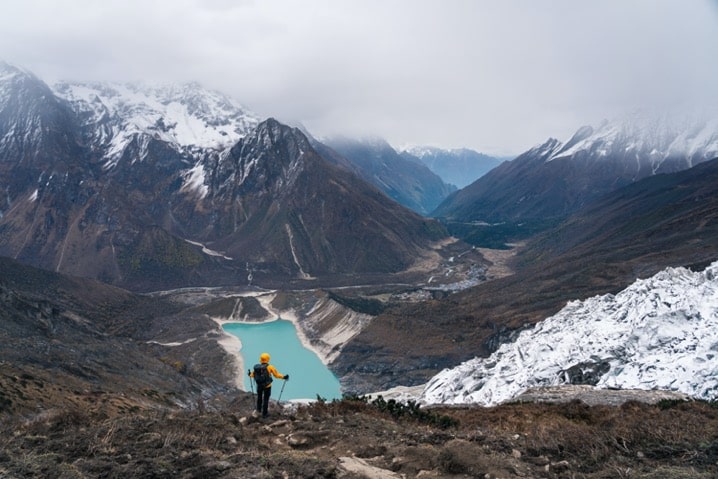
This is the day of acclimatization at Sama Gaon to prevent altitude-related illness. As an acclimatization hike, you will walk to Pungyen Gompa, east of the Nubra Valley. On this acclimatization hike, you have to take a packed lunch.
Once at the hilltop, you will get enticing views of Manaslu. Nearby, you will see many Himalayan Thars and Yaks grazing.
You can also hike to Manaslu Base Camp north of Sama Gong. You can follow the trail past Birendra Tal and turn left onto the base camp track.
You will climb the steady trails. However, the altitude may cause breathing difficulty. So, you need to maintain body hydration and walk slowly. Proceeding slowly, you will walk north of Manaslu Glacier to basecamp at 4,400m / 14,435, then return.
Or, you can hike to Birendra Tal, a short walk from Sama Gong. This is an option if you feel the need for a rest or if you are finding the altitude difficult.
Day 8: Sama Gaun to Samdo
- Trek time: 2 to 3 hours
- Accommodation: Tea House
- Distance: 10 km / 6 miles
On this new day, you will reach the newer destination, i.e., Samdo. But, as you are at a high altitude, you must walk slowly, so this is a short day trek. You will notice extended yak pastures up a broad valley with long mani walls and various birds.
From there, you will leave the treeline and climb to a ridge across the wooden bridge of Buri Gandaki before you reach White Kani. It is a village neighboring Samdo, a very picturesque village dedicated to yak herding.
Once at Samdo, you can explore the nearby villages or hike to Samdo Peak. The Larkya La trail is on the left above the valley. You can also see the main track for Tibet over the Larjyang La forming slopes on the Larkya La trail.
Day 9: Acclimatization Day (Day Trip to Tibet Border)
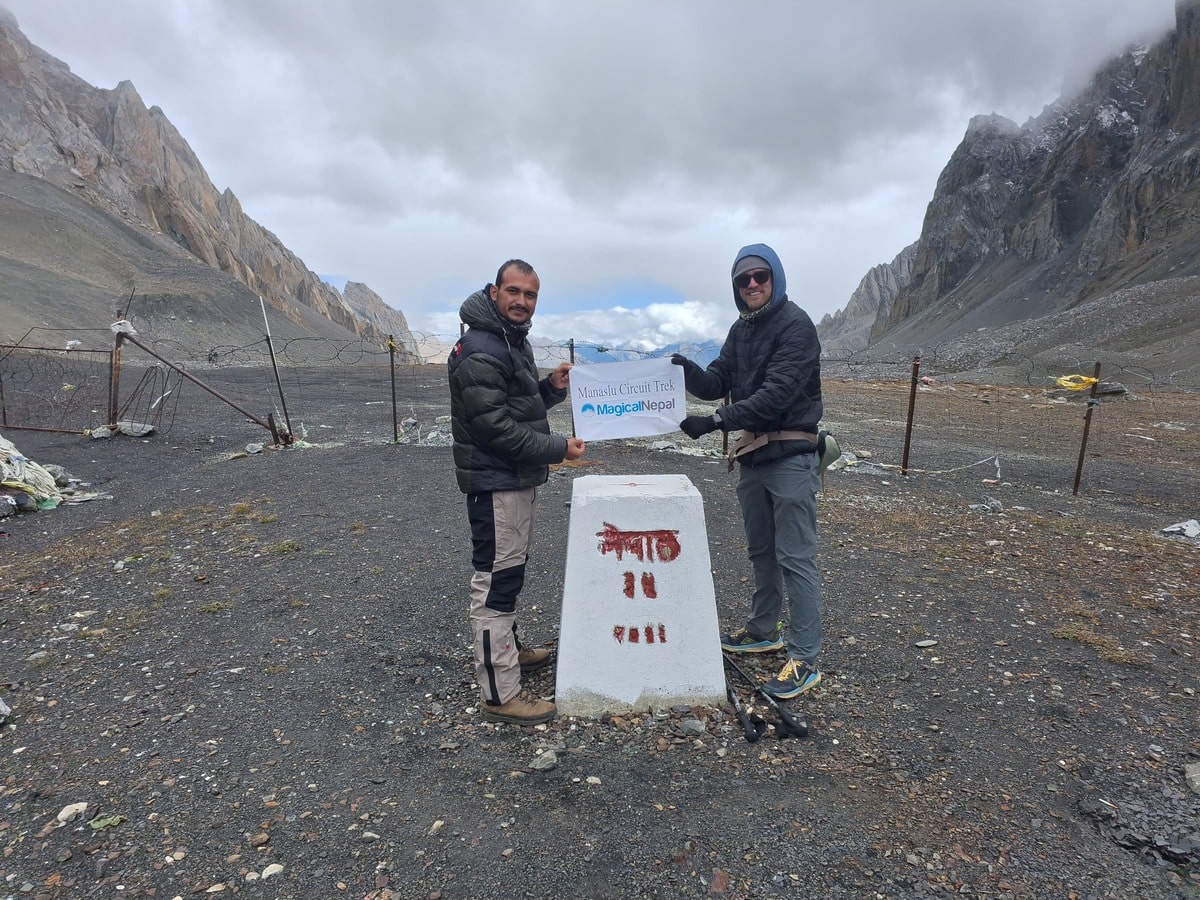
- Trek time: 8 hours
- Accommodation: Tea House
- Distance: 12 km / 7 miles
On this day of rest, you will stop at Samdo and then go on a day trip to the Tibetan border. From the border, you can see parts of Tibet and Nepal. If lucky, you can also witness the Yak caravan passing the border.
Once at the border, if you look south of Samdo Glacier, you will get excellent photos of a huge serac near the top of the glacier. You can also frame Blue Sheep, picas, and Marmots in season.
Day 10: Samdo to Dharmasala
- Trek time: 3 hours
- Accommodation: Tea House
- Distance: 3 km / 1 miles
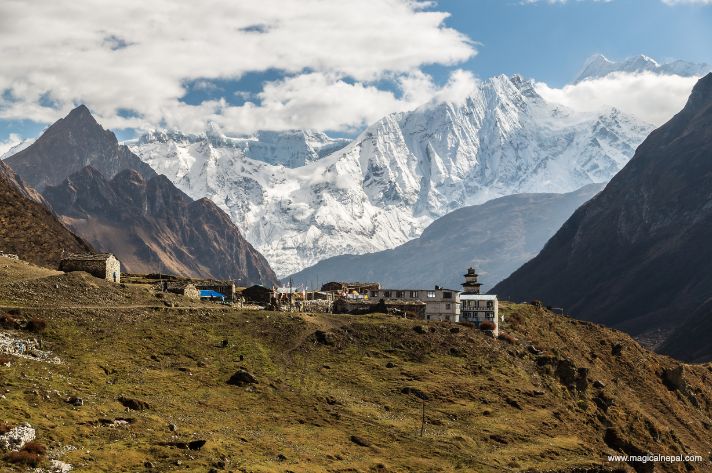
Today’s a relatively easy 3-hour hike. While Dharmsala might look within arm’s reach from Sambdo, the altitude adds a challenge, making the journey a bit longer.
This is another adventurous day at a high altitude. So, you must watch your body signs properly.
Enjoying scenic views of the Himalayan chain, you will walk slowly across the rugged terrains of the Manaslu region before you reach Dharmasala.
Day 11: Dharmasala to Bimthang via Larkya Pass
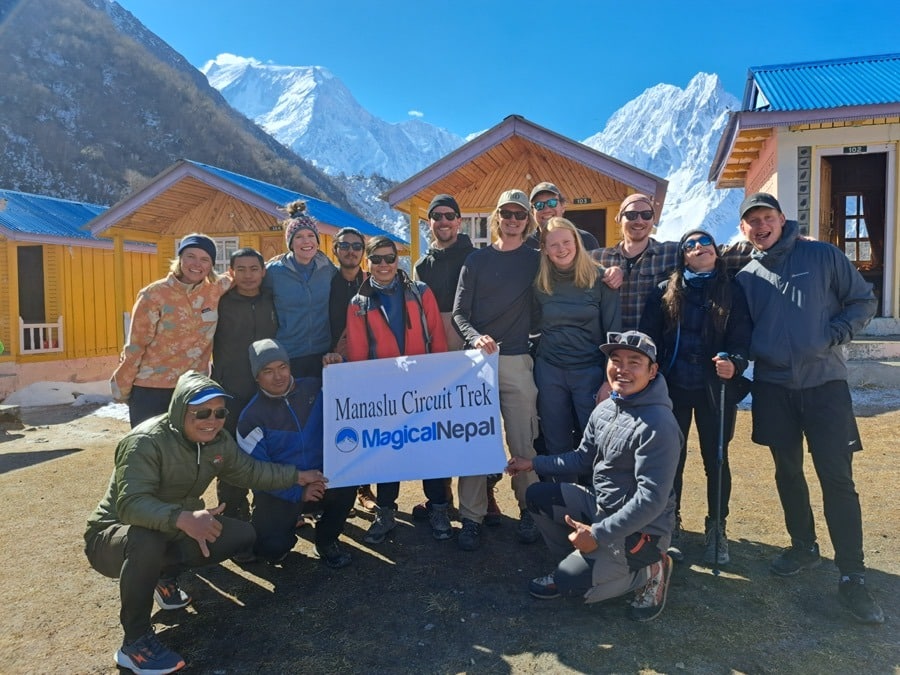
- Trek time: 10 hours
- Accommodation: Tea House
- Distance: 18 km / 11 miles
This is a special day as you will walk to the trail’s highest point. On this day, you will walk to Larkya La Pass (5,160m / 16,929 ft). The walk could be quite challenging in bad weather and the snow, yet it is doable.
You will cross the pass before the afternoon, so you must wake up early( 3 a.m.), have breakfast, and leave the teahouse early. This is the challenging part of the trek, but if you walk steadily, you can successfully cross the pass.
The stunning views you will witness once you stand at the pass make the trip more enlightening. You will catch views of Himlung (7,126m/ 23,379 ft) near Tibet Kang Guru (6,981m /22,903 ft), and Annapurna II (7,937m / 26,040 ft) in the Annapurna Range.
Spending your particular time at the pass, you will walk down for around 3 hours toward Bimthang for an overnight stay. On descending, you will get views of huge icefalls and mountains in all directions, Pongkar Tal between the Pongkar and Salpu Danda Glaciers.
Day 12: Bimthang to Dharapani
- Trek time: 7 hours
- Accommodation: Tea House
- Distance: 21 km / 13 miles
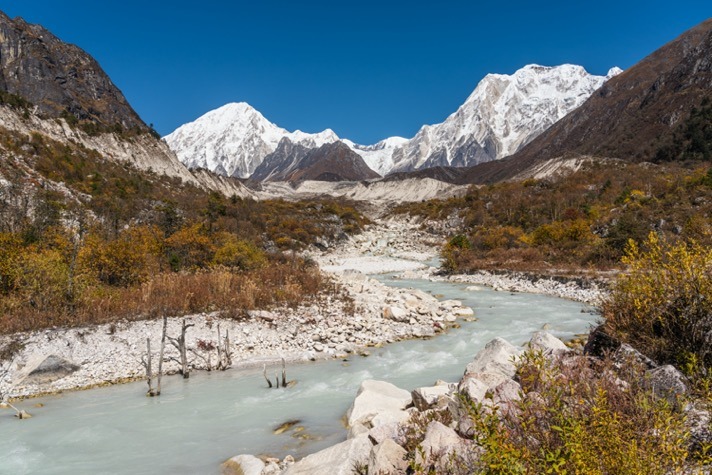
This is the final day you will be walking the trails of the Manaslu region. As you climb downhill, you will pass lush forests full of flora and fauna, including rhododendron bushes.
Walking back across the Dudh Khola, you will walk to Karche for lunch. In the next hour, you will see many signs of a glacial flood, with tree trunks smashed and banks undermined, the track becoming rough. And the trail drops to Gurung Goa, the first village since Samdo.
The valley becomes more agricultural and lush as you pass fields and copses of oak and rhododendron. Stay on the north (true right) bank until Tilije. From there, continue your stroll toward Dharapani.
Day 13: Dharapani to Kathmandu
- Trek time: 7 hours
- Distance: 243 km / 143 miles
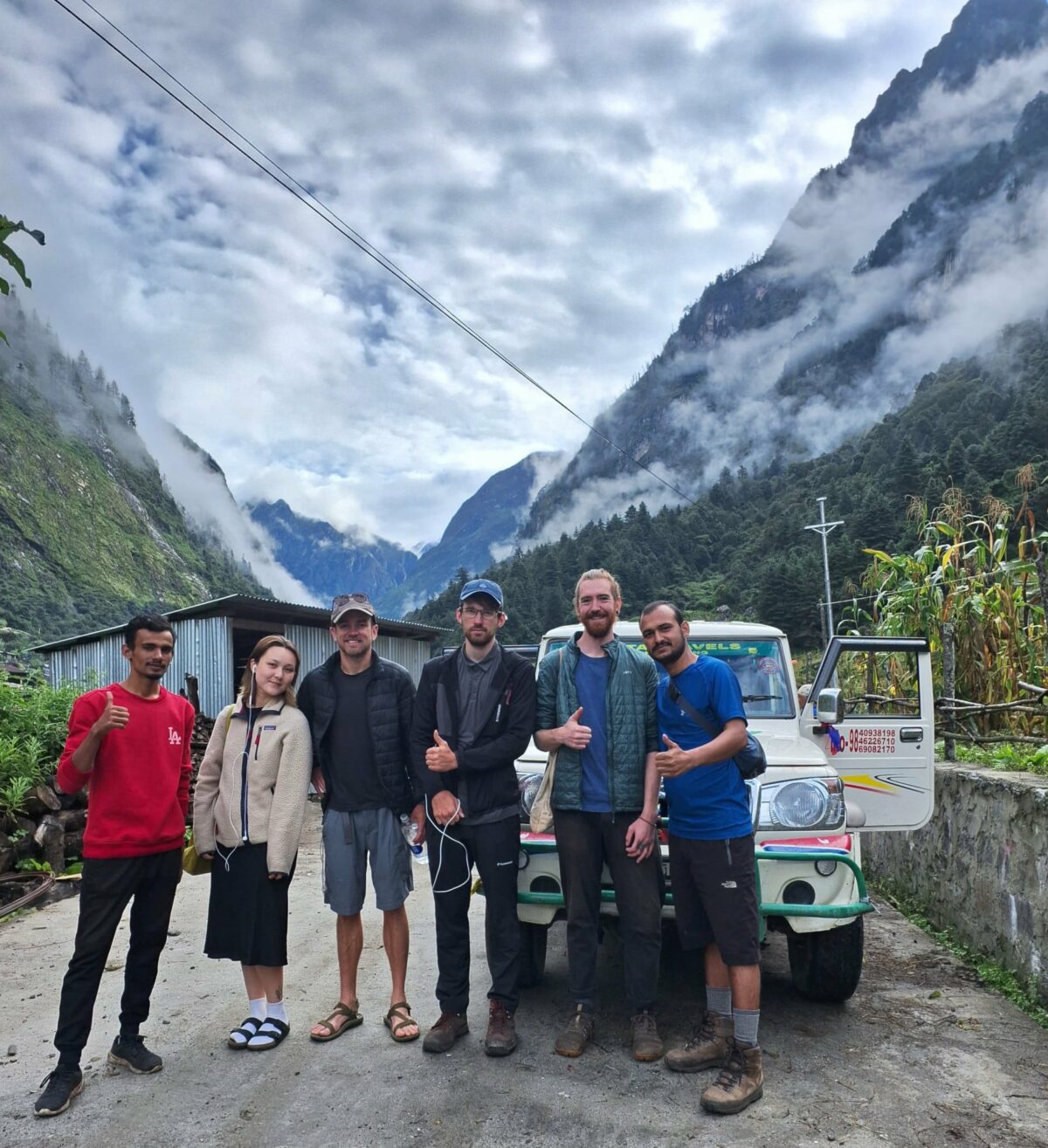
You will take a jeep from Tilije to Beshi Sahar. From there, you will take a ride back to Kathmandu. After the 6 – 7 hours drive from Beshi Sahar, you will get to rest in one of the sophisticated hotels in Kathmandu.
Not satisfied with this Itinerary?
Are you interested on planning custom trip? It only takes 2 minutes.
Transportation for Manaslu Circuit Trek
Start: Transportation from Kathmandu to Maccha Khola
Your journey to the Manaslu region begins with an exciting drive from Kathmandu to Maccha Khola, passing through Soti Khola. Private jeeps cover the 160 km (99 miles) in about 7 hours, while local buses take 8-9 hours. Expect a thrilling off-road adventure on the first day!
End: Dharapni to Kathmandu
After your trek, you’ll take a 6-hour jeep ride from Dharapani, then switch to another jeep or bus for the 7-hour journey back to Kathmandu.
Magical Nepal Makes it Easy.
We’ll take care of the logistics! Your guide will meet you at your hotel and accompany you to the bus station via a short taxi ride. Buses usually leave between 7-8 am, but we’ll confirm the exact time on a trip briefing day
Do you prefer private transport?
We’ll arrange for it to pick you up directly at your hotel. To beat Kathmandu traffic, we recommend an 8 a.m. departure, and you can enjoy a leisurely lunch stop along the way. For Dharapani to Besisahar, we use the private transport available in the region.
Know more about how to get to the Manaslu Circuit
Permits for Manaslu Circuit Trek
Manaslu Trek is a restricted region. You will need a special restricted area permit, which a local company can issue. You will also need ACAP and MCAP permit for the trek. Two trekkers are compulsory for the trek.
Know more about the Manaslu circuit trek permits
Accommodation for the Manaslu Circuit Trek
Manaslu is a teahouse trek. You will sleep in a very basic teahouse every night, with two single beds. Toilets are mostly shared and can be outside teahouses. Heating is only available in the dining area. Food is available in teahouses. You will stop in teahouses for lunch during the trek.
Check out the Manaslu circuit accommodation options.
Stay Connected on the Manaslu Circuit Trek: Telephone and Wi-Fi Options
Wifi is available in most tea houses. If you want to communicate back home, there is an SAT phone available in tea houses which takes a little bit of extra money to make a phone call back home. Local telephone hardly works on this trek. Nepal Telecom has better coverage than Ncell in the Manaslu region.
Know about Telephone and Wi-Fi coverage in Manaslu Circuit
Estimated Temperature in Manaslu Circuit
The chart provides a general overview of the weather conditions during the Manaslu Circuit trek. The Daily Chart specifically focuses on the popular trekking seasons of Spring (March to May) and Autumn (September to mid-December), detailing the daily maximum and minimum temperatures during these periods. For a more comprehensive understanding of temperature fluctuations in other seasons, it’s recommended to refer to the Monthly chart.
While Manaslu typically does not experience heavy monsoon rains during Spring and Autumn, it’s still advisable to carry a rain jacket due to the unpredictable nature of weather in mountainous regions. Packing for the worst-case scenario ensures you’re prepared for any unexpected changes in weather conditions during your trek. For further guidance on essential items to bring along for your trek, please refer to our Equipment list.
Temperature in:
Altitude Profile of Manaslu Circuit Trek
Altitude in:
Includes
- 12 nights accommodation in mountain teahouses
- Guide for 13 days
- Kathmandu Maccha Khola, Dharapani Kathmandu Local Bus
- Manaslu & Annapurna conservation area permit
- Restricted area permit
- 13 x breakfast, 13 x lunch and 12 x dinner while on the trek
- One Porter for 13 days USD 299 (Optional)
- Private Jeep USD 440 (Optional)
- Any hot or cold drinks
You can make your trip reservation using our booking system. Simply indicate whether you prefer a private departure or a Fixed Group Departure, select your preferred date, and proceed to book now. Our booking system will promptly collect all the required details from you. Be assured that your trip will be confirmed promptly upon receiving your booking.
Equipment Checklist for Manaslu Circuit
The following Manaslu Circuit trek Packing List gives you a general idea of the trekking equipment and clothing needed for the Manaslu Circuit trek.
Manaslu Circuit Trek Map
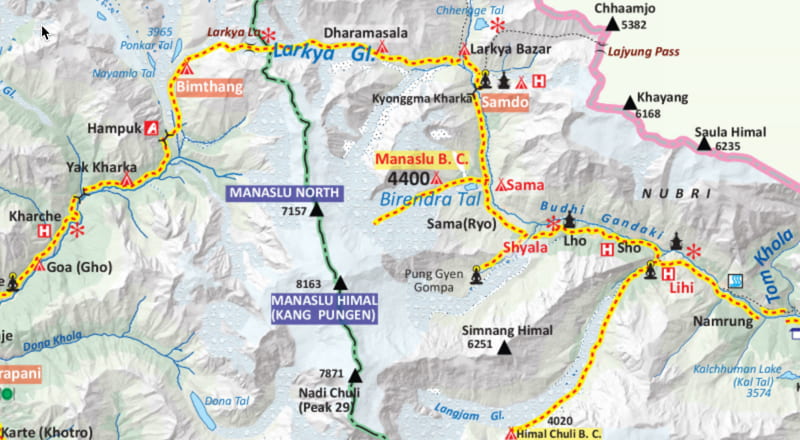
Manaslu Circuit Trek FAQ
Arrival and Visa in Nepal
Can I get a visa on Arrival in Nepal?
Yes, you can obtain the visa on arrival.
The visa fee for Nepal varies depending on the length of your stay. For a 15-day multiple-entry visa, the fee is USD 30. For a 30-day multiple-entry visa, the fee is USD 50. For a 90-day multiple-entry visa, the fee is USD 125.
Citizens of these countries don’t get visas on arrival: Nigeria, Ghana, Zimbabwe, Swaziland, Cameroon, Somalia, Liberia, Ethiopia, Iraq, Palestine, Afghanistan, Syria, and Refugees with travel documents.
It is recommended to check with the Nepalese embassy or consulate in your home country before traveling to Nepal to confirm the current visa requirements and fees.
How do I get from the Airport to my hotel?
You can ask your hotel to arrange the transport for you or request an airport transport from us. Please choose “Airport transfer” to yes on the booking form. Our representative will be there to pick you up from the Airport.
How do you transfer me from Tribhuvan International Airport to my Hotel?
Upon your arrival, our representative will be waiting for you outside the arrival terminal. Please keep an eye out for a name card displaying your name. We ensure a smooth pick-up process to start your journey with us on the right note.
Magical Nepal Guide for Manaslu Trek
Can I do Manaslu Circuit without a Guide?
The guide is mandatory for the Manaslu Circuit trek. You can’t do it without the guide.
Can your guide speak English?
Absolutely! Our guides are proficient in English and are well-trained to provide comprehensive explanations about the local culture, traditions, and the areas you’ll be exploring. Not only can they offer insights and stories to enhance your experience, but they also act as a bridge between you and any locals you might meet along the trail who don’t speak English. With our guides by your side, you can be assured of a seamless, enriching, and interactive journey.
How experienced is your guide? How well do they know the Manaslu Region?
The Manaslu Circuit Trek is our top-selling trek, and as a result, our guides visit the area multiple times a year. This frequent exposure ensures they know the region inside out.
Required Permits
Do I have to issue my permit for Manaslu Circuit Trek?
No, Magical Nepal will issue the permit on your behalf. You don’t have to do anything.
What documents do you need for the permits?
We need your original passport for the permit. We also need a scanned copy of your passport which you can submit on our booking portal. It helps to arrange all the necessary documents for your permit before your Arrival
What Permits do I need for the Manaslu Circuit Trek?
You need a Manaslu Restricted Area, Annapurna Conversation Area Permit(ACAP), and Manaslu Conversation Area Permit(MCAP).
Why do I need an ACAP Permit for Manaslu Trek?
You will be walking in the Annapurna Conservation area at the end of the trek. Thus, you need an ACAP Permit.
Manaslu Circuit Trek Cost
What is covered in the amount I pay for Manaslu Circuit Trek?
Your guide, all the required transport, permits, and Three meals a day are included in the cost. Drinks and snacks are not included in the cost. Porter and private transport cost an additional amount. You can select porter and private transport if necessary during the checkout process.
You can learn more about the Manaslu Circuit trek cost here
How much money do you recommend to take us on the trek?
We advise you to carry an additional 10 to 15 USD per day for your trek. Please note that cards and foreign currency are not accepted in the trial. It’s essential to have Nepali Currency (Rupee) with you for all transactions during your trek.
What are the extra costs of the trek?
A hot shower will cost between 3 to 5 USD, and charging a device will also be in the range of 3 to 5 USD.
How much does it cost to trek the Manaslu Circuit?
On this trek, it is mandatory to take a guide and the permit is more expensive. So you should calculate it will cost around USD 986 per person on a twin-sharing basis. If you add in a porter and private jeep transport it can cost up to around USD 1300 per person.
How far is Manaslu from Kathmandu?
Manaslu is about 123 km aerial distance from Kathmandu to the Northwest. The starting point of the trek is around 126 km from Kathmandu.
How High Will I Go on the Manaslu Trek?
There is no airport in Manaslu so the only option is to travel by road. The choice then is a local bus taking around 8 hours or a private jeep which will take around 6 hours including breaks.
When is the best time to trek in Manaslu?
Like many other treks Manaslu is best between mid-September and mid-December, and between the end of March and Where is Manaslu? to the end of May. Some trekkers do undertake this trek in the monsoon between June and September but very few would choose the winter.
Where is Manaslu?
Manaslu is located Northwest of Kathmandu. It is bordered by Annapurna to the west and Langtang Ganesh Himal to the east.
How cold is it at Manaslu?
At the start of the trek, the climate is subtropical. Overall you can expect somewhere between 10 to 25 Celsius throughout the year. However, in the upper parts of the trek, the temperature will fall to -20 or below in the winter.
Booking Process and Cancellation
How Can I book the Manaslu Circuit trek with Magical Nepal?
You can select the date from our fixed departure date and click on Book Now. Our system will guide you through the rest. If you decide to do a private trip. You can select a private trip during the checkout.
My dates are not listed in the Fixed Departure Date
You can click on Ask Question and request your booking date. We will add it and send you the booking link.
Accommodation and Food In Manaslu Circuit Trek?
What kind of food is available in Manaslu Circuit Trek?
There is a variety of Western and Nepali food available on the trek. Meals are both vegetarian and vegan-friendly. You can see more about the food availability in Manaslu Circuit Trek here.
What kind of accommodation is available in Manaslu Circuit Trek?
Accommodation are basic in Manaslu Circuit Trek. There are twin beds in the room with a mattress. You have to carry your sleeping bag. Toilets are shared. Heating is available only in the Dining Room. There is limited accommodation in Dharmasala before Larke Pass. You might have to share the room with others on this day. Our Package doesn’t include Hotels in Kathmandu
I want a single room in Manaslu Trek. What should I do?
You can add “Private Room” during the checkout for the single room. Please, note we can’t guarantee a single room in Dharmasala before Larka passes as space is limited there.
Do you have any hotel recommendations in Kathmandu?
Luxury Hotel: Marriot Kathmandu, Dwarika Hotel, Aloft Hotel, Shankar Hotel
Budget Hotel: Bodhi Boutique Hotel, Kumari Boutique Hotel
Is it possible to have a shower in the trek?
Yes, it is possible to do a Shower in the trek. Hot showers cost roughly (USD 3 to USD 5)
Can I do Laundry in the trek?
Laundry service is not available in the trek. You can wash your clothes with your hands if you want to.
Luggage and Storage in Kathmandu
What is the ideal weight for my Backpack in Manaslu Circuit Trek?
We recommend you pack light. The ideal backpack weight is 8 to 9 kg (17 to 22 lbs).
What is the weight limit of the porter?
The weight limit of the porter is 20 kg. We provide a Duffle bag if you hire a porter.
Do you provide a storage facility at our office?
We provide free storage at our office. Most of the hotels in Kathmandu also provide free storage. We recommend you check with your hotel.
Can you ship my luggage to Pokhara after the trek?
Yes, we can ship your luggage to Pokhara without additional cost.
Payments and Extra Costs
Do you accept the remaining payment in Cash? What currency do you accept?
We accept all major currencies. If you want to pay by card it is a 3.5% extra bank fee.
How much extra money do you recommend on the trail?
We recommend carrying USD 10 to USD 15 a day. Credit cardsWhat are the extra costs that I am not aware of? and other currencies are not accepted in the trek. We recommend you carry local currency.
What are the extra costs that I am not aware of?
Your Guide, accommodation, food, and transport are included in the price. Drinks are not included in the price. Hot shower costs extra in teahouses (USD 3 to USD 5).
It costs extra to charge your phone, camera battery (USD 2 to USD 4 per charge) Wifi costs extra as well (USD 3 to USD 5).
Trek, Safety, and Altitude
Should I be worried about Altitude Sickness in Manaslu Circuit Trek?
The Manaslu Circuit Trek starts at an altitude of 800 m (2,624 ft) and you’ll approximately gain an elevation of 400 m (1,312 ft) each day. By Day 6, you will have ascended to 3,000 m (9,842 ft), providing ample time for your body to acclimatize.
Furthermore, there are two designated acclimatization days, one in Samagaun and another in Samdo, to ensure your body adjusts comfortably to the high-altitude environment.
Should I be worried about Altitude Sickness in Manaslu Circuit Trek?
The Manaslu Circuit Trek commences at an altitude of 800 m (2,624 ft) and you’ll approximately gain an elevation of 400 m (1,312 ft) each day. By Day 6, you will have ascended to 3,000 m (9,842 ft), providing ample time for your body to acclimatize.
Furthermore, there are two designated acclimatization days, one in Samagaun and another in Samdo, to ensure your body adjusts comfortably to the high-altitude environment.
How Safe is Manaslu Circuit Trek?
The Manaslu Circuit Trek is generally safe. However, we advise against attempting it during the monsoon season due to its susceptibility to landslides. Outside of this period, the trek is considered safe for travelers.
What do you do in case of an emergency?
Our guides are rigorously trained to assess and handle emergencies with the utmost precision and care. They are equipped to provide basic immediate attention as the situation demands. In dire circumstances, we coordinate swiftly with helicopter services and your insurance provider for an emergency rescue. Your safety and well-being are our top priorities, and we ensure that we are prepared for any unforeseen situations that may arise during the trek.
How difficult is the Manaslu trek?
The Manaslu Circuit Trek is challenging mainly due to the Larkya La Pass which has to be crossed, being over 5,200 m /17,060. Descending from the top of the pass is hiking over loose rocks on a steep trail. What’s more, compared to tea houses on other mainstream treks, the accommodation and food are basic on this trek. Making it more of a rugged experience.
How long is the Manaslu Circuit?
The best way to do this trek is to take 13 days from Kathmandu to Kathmandu. It can be done in 10 or 12 days but that would be rushing the trek, and perhaps missing out on some of the experience. Not to mention it will be harder and more tiring on the body. If you have time, consider a side trip to the wonderful, recently opened, Tsum Valley. This will increase the duration of the trek to 20 to 22 days.
A Typical Day on the Manaslu Circuit Trek
This trek is both challenging and rewarding, featuring lengthy days of hiking, often at high altitudes. To help you acclimatize and maintain your health and fitness, we’ve included a couple of rest days in the itinerary. Each day of the trek is a new adventure, filled with breathtaking sights and opportunities for photography. Here’s a glimpse of what a typical day looks like:
The day begins early to maximize daylight hours. After a night’s rest in a cozy teahouse, you’ll start with breakfast at the lodge, fueling up for the day ahead. The trail will lead you through diverse landscapes – from encountering mules on the path to traversing rocky terrains, crossing rivers, and wandering through forests, all while marveling at the majestic mountains.
The region’s proximity to Tibet means you’ll witness the influence of Tibetan culture, evident in the fluttering prayer flags and various Buddhist artifacts along the way.
The centerpiece of the trek is, of course, the magnificent Manaslu, surrounded by other awe-inspiring snow-capped peaks in this secluded area.
Lunch is usually enjoyed on the trail, in quaint eateries catering to travelers and trekkers. We might carry a packed lunch on certain days, depending on the route and conditions.
Dinner is served in the same teahouse where you’ll be staying. This is a wonderful time to bond with your fellow trekkers and guides. During dinner, your guide will brief you on the next day’s route, highlight any special points of interest, and answer any questions you might have. It’s customary to order your breakfast the night before, ensuring it’s ready when you wake up early the next morning, eager to embark on another day of adventure.
What to Expect in a Teahouse in Manaslu
A teahouse is like a simple guest house on the mountain trails. It provides trekkers with accommodation, meals, and a place to socialize. Overall, these provide basic accommodation in twin rooms or dormitories. Toilets and bathrooms are shared, with either a Western-style toilet or a squat style.
Showers normally only have cold water; you will be expected to pay for it in those with hot water. The sleeping rooms consist of beds, blankets, and not much else. Bringing your sleeping bag is always recommended. There are no ‘single rooms’ unless it is off-season, and you are lucky. Sharing a room is perfectly normal. There is no heating in the sleeping rooms.
Some stoves usually warm the dining area. Light is provided by solar power, although most teahouses charge your gadgets, for which you have to pay. Breakfast and dinner are taken in the teahouses at communal tables where you can discuss the day’s journey with others.
Some menus offer a variety of food. Boiled water is usually available, rather than in plastic bottles, which hurts the environment. There is a small charge for boiled water. Bringing your sterilization tablets/ life straws is a good idea.
What kind of Food is available on the Manaslu Trek
As this is a restricted area, with a limited number of trekkers allowed each year, the teahouse menus are not as extensive as on some older, more established, and busy trekking routes. However, the food is hearty and hot. The village of Namrung has a guest house with a more modernized restaurant and even a cappuccino! But if that is not open when you go there, bringing snacks is always a good idea.
Breakfast at your overnight teahouse on the Manaslu Trek:
- Spicy Nepali omelet with chili, onion, and tomatoes or piping hot porridge with milk
- Toast or Tibetan bread with jam or honey
- Nepali spiced tea, salty Tibetan tea (in some settlements), or coffee (if available)
Lunch at a small teahouse on the trail on the Manaslu Trek:
- Dal bhat (rice, curry, lentils) or noodles
- Nepali tea or a soft drink
Dinner at your overnight teahouse on the Manaslu Trek:
- A variety of soups i.e., garlic soup
- Tibetan bread (when available)
- Momos (packets of vegetables or meat Tibetan style, when available)
- Fried noodles with vegetables
- Dal Bhat
- Fried rice
- Rice pudding
- Soft drinks and beer, Nepali tea
Are There Hot Showers on this Trek?
If hot water is available for a shower, you will be expected to pay around $3 to $5 per shower, depending on the height of your lodge. This is because hot water is usually generated by gas cylinders, which must be carried up the mountain at some effort and expense. We recommend you conserve energy (and your money) and not shower too often. The effort to take off and put on clothes might be too much in cooler weather.
How High Will I Go on the Manaslu Trek?
The day you visit the Tibetan border, you will reach 5,000m/ 16,404ft, and at the Larky La Pass, you will be at 5,167m/ 16,952 ft, the highest point on the trek.
You will sleep one night at 4,460 m /14,632ft, which is quite high. But by then, you will have had two acclimatization days and are well into your trek, so your body will be used to the high air.
Trek Difficulty and Physical Fitness Required for this Trek
Manaslu Circuit is a challenging trek, we do not recommend it for inexperienced trekkers. You should be in very good physical shape to tackle this trek. The high altitude makes it challenging for everyone, but it might be a real struggle for those who are unfit or have some medical problems. But if you are fit, this is a wonderful trek and will push you to achieve more!
Will I Suffer from Altitude Sickness on the Manaslu Trek?
Going above 3,000 m-3,500 m can cause some people to feel some effects of altitude. As you can see, this trek goes up to over 5,000m. But there is plenty of time on the trail and the two acclimatization days for our bodies to adjust to the height.
All Magical Nepal guides are well experienced (with an average of 7 years of trekking experience each) and know what to look for and do if anyone is feeling unwell. Please tell your guide if you feel unwell at any stage of the trek.
Extending your Stay in Nepal – Many Options
Extending your Manaslu Trek
It is possible to increase this trek from 14 to 21 days by including the newly opened and incredibly interesting Tsum Valley; please ask us about this or check the website page.
Extending your Stay to Other Parts of Nepal
If you are interested in staying longer in other parts of Nepal, we can organize that for you too, and recommend the best treks and trips to suit your time and budget. Please ask us. For example, we can point you to or organize transport and accommodation to go to Pokhara after you finish your trek.
If you would like to visit another part of Nepal, we can recommend both Chitwan National Park and Bardia National Park. If your time is short, we can provide Kathmandu Heritage sightseeing with a guide, taking you into a fascinating ancient world and culture.
Trip Extension National Parks
Both Chitwan and Bardia are beautiful national parks in Nepal. But both are different regarding location, difficulty getting there, facilities, and, to some extent, wildlife.
Chitwan is close (around 5 5-hour drive or a short flight) from Kathmandu and has been established as a national park for visitors for decades. It is easy to spend 2 nights in Chitwan with little difficulty because of the distance to Kathmandu.
As a result, there is a wide range of accommodations, some quite luxurious. There is also a range of restaurants and bars in the tourist town of Sauraha for those who would rather party the night away. The wildlife guides provide walking safaris, jeep safaris, and short canoe rides. The main animals of interest are rhinos, deer, leopards, monkeys, and smaller mammals. Tigers do live here but are quite difficult to spot. Chitwan is also on the road we will take at the end of the Manaslu Trek to reach Kathmandu; please ask us about this.
Bardia National Park is situated at the other end of the country and takes around 12 hours to reach by road or 1.5 hours by flight and then 2 hours by car. We recommend staying at least 3 nights to fully enjoy the ambiance here. It is less busy with tourists and more rustic regarding accommodation and local villages.
Wildlife here includes tigers, elephants, leopards, monkeys, and deer. Like Chitwan, there is a huge range of birdlife for those interested in bird watching. Jeep and walking safaris are offered, as is rafting on the river and perhaps fishing. Nightlife is more confined to your lodge.
There are now options for wildlife spotting between these two parks. The village of Megauli, which is really in Chitwan District, is an up-and-coming place in luxury lodges. Currently, it does not see a lot of visitors but offers the same safari options of the jeep and walking safaris. It is more difficult to get to than Chitwan and requires either a private vehicle or to be collected from the nearest big town by the lodge vehicle.
Cost and the Booking Process for the Manaslu Trek
You can book your Manaslu circuit trek and other trips via our booking system, which will collect all the necessary information from you. You can pay the deposit or the full amount via credit card. The cost is on the relevant web page.
Charging Your Equipment on the Manaslu Trail
Many teahouses on this trek have electricity or solar-powered electricity. However, as almost everyone carries some chargeable device these days, the teahouse owner will pass the cost on to the visitor.
Generally, teahouses will charge you $2 to $3 for your phone or camera. This can become expensive as there are so many wonderful things to photograph. We recommend you carry a power bank or a small solar charger to avoid paying too much. Some great solar chargers clip onto your day pack.
Group Size for the Manaslu Circuit Trek
Your trekking group is generally 8 people, but it is often smaller. If you require a tailor-made private trek, you can choose this option at no additional cost during checkout.
We have found that trekking with a group makes the trip more fun, especially during the evening relaxation.
Do I need a Porter for the Manaslu Trek?
We do not provide porters for the Manaslu Trek. It is entirely up to you whether you think you require one. There are a lot of high mountain trails to cover and long hours of walking, so unless you have experience carrying your kit in this kind of landscape, it might be worth considering. A porter costs USD 231 for the duration of the trek. The porter can carry up to 20kg, so you can split the cost with a friend as long as the combined weight is under this amount. You only need to carry a day pack with what you need during the day, i.e., water, sunscreen, camera. Porters are amazing people used to walking at altitude and on these rough trails, so they walk faster than the average trekker. They will head off ahead of you and reach the teahouse first, where they will deposit your bag.
How do I get From Kathmandu to Machha Khola?
We will arrange to collect you from your hotel in Kathmandu and take you to the local bus station. The local bus to the starting point of the trek takes around 7 hours on the way there and around 10 hours on the way back. Should you require a private jeep, the cost is USD 440 each way. Each jeep takes the driver, your guide, and three or four trekkers.
Arriving in Kathmandu before the Trek
We do not provide hotel accommodation in Kathmandu for this trek but provide airport pickup. Please check your name card before at the arrival gate. A few people might come up to help you with your bag and later ask for money. Ignore them.
Meeting the Magical Nepal Team Before the Trek
We will provide you with a contact number, day, and time to meet us and your guide before your trek. Please also advise us which hotel you will stay in before arriving.
Travel Insurance for your Trek
While our insurance covers our team, you are not covered by this. Please ensure you have the correct travel insurance before leaving home. Please ensure your insurance covers trekking at high altitudes and helicopter rescue should it be required.
Safety and Security in Nepal and on the Manaslu Trek
In general, Nepal is a very safe country. But please check your home government’s website for the latest information. There may be demonstrations – if you see one, please avoid it. Theft is unusual, but it does happen. Ensure all your valuables are hidden from sight. You can leave any valuables in our office locker while on your trek.
It is unlikely, but if there is any landslide, avalanche, flooding, or earthquake on the mountain, please follow instructions from your guide. Similarly, if you feel unwell at all, please advise your guide.
Tipping Culture in Nepal
It is expected in restaurants and cafes to tip 10% of the bill. Tipping your driver, porter, guide, and other staff on your trek is also normal. Please tip drivers of private vehicles separately for $ 1 to $5, depending on the length of the journey. Normally tips for the trekking crew are given as a group and depend on the group’s satisfaction.
How Much Cash Should I Take on the Trek?
We recommend carrying between USD 10 to USD 15 daily on the trek. This will cover things like a hot shower and charging batteries. It also will cover the occasional soft drink or beer. It will not cover tipping your crew/guide. Know more about the Manaslu circuit trek cost
Local Dress and Culture in Nepal
Please respect the local culture. For example, when entering someone’s house, please remove your shoes and leave them outside. This does not apply to trekking lodges. Please dress conservatively.
Please do not wear short shorts or skirts when trekking in the warmer lower altitudes. Aside from upsetting some locals (who most likely will not say anything to you but are thinking it), there are mosquitos and can be sharp vegetation.
Long or cropped trekking pants are best. Please dress respectively when visiting religious sites of any kind. Public displays of affection between men and women are still rare in Nepal. Whatever you may witness in the bars of Thamel is not common outside in rural areas, even the more popular ones.
Money Exchange in Kathmandu
There are plenty of ATMs in Kathmandu that provide Nepali currency. There are no ATMs on the trek. The ATMs accept Visa and Mastercards and have a limit on each withdrawal. Some shops in Kathmandu and other big cities accept Visa and Mastercard, but there will be a 3 or 4% charge for each transaction.
The rate of exchange varies daily at both ATMs and money changer booths. Money changer booths will only change hard currency into Nepali rupees. They do not accept cards. Often it is easier to bring some US dollars, Pounds, Australian Dollars, Singaporean Dollars, Malaysian Ringgit, and Euros with you.
Why Do I Need to Pay for a Restricted Area Permit?
This area is considered restricted because of its proximity to Tibet. Foreigners need to pay for a restricted area permit. On the bright side, this means we see fewer trekkers on the trail, and the whole atmosphere is like an expedition rather than a commercial trek.
Magical Nepal arranges permits for its client
Feedback on the Manaslu Trek
We would love to hear from you after your trek. Please give your suggestions on how to improve and tell us how much you enjoyed your time with us.
Important Notes for the Manaslu Trek
- Transport is by public bus. Please let us know if you wish to use private transport, which will involve an additional fee.
- There is no extra charge for a solo traveler. But please note that you can get a single room on the trek is highly unusual. Expect to share with someone (of the same sex).
- This trek does not include accommodation in Kathmandu. Please let us know in advance if you would like us to book this.
- Porters are not included in the package price. Please ask us before the trek if you wish for a porter to carry your gear. There will be an additional charge for this of USD 299.
- If you hire a porter, the maximum he can carry is 20kg. Please be respectful of this.
- Three main-course Meals on the trek are included in the price. However, hot or cold drinks, alcohol, snacks, or extra food are not included.
- Extra charges for hot showers ($3 to $5) and charging your battery ($1 to $3) are payable directly to the teahouse on the trek.
- Always listen to your guide. He has experience in this area, and if there are sudden changes to be made (because of weather or landslides), he will be responsible for making decisions.
- Drones are not permitted unless you have a special permit to fly them. Obtaining permission can be tricky, so leave it at home unless you need a drone.
- Please arrange trekking insurance before leaving your home country. We do not provide insurance for our clients.
- And finally, enjoy your adventure with Magical Nepal!
- Satisfied Client
- Personalised Guide
- Instant Response
Get Instant Response:
+977-9851329446 (Whatsapp)
